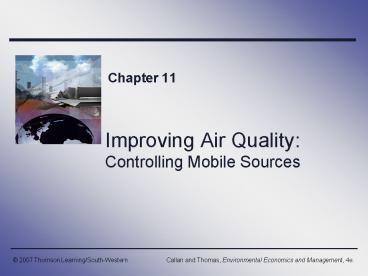Improving Air Quality: Controlling Mobile Sources PowerPoint PPT Presentation
1 / 9
Title: Improving Air Quality: Controlling Mobile Sources
1
Improving Air Quality Controlling Mobile Sources
- Chapter 11
2
Understanding Urban Air Problems
3
Measuring Urban Air Quality
- EPA monitors the air in relatively large
metropolitan statistical areas (MSAs) and reports
part of its findings using the Air Quality Index
(AQI) - AQI is reported as the highest of five
pollutant-specific index values (ranging between
0 and 500) for that day and signifies the worst
daily air quality in an urban area over a given
time period - The pollutants monitored are five of the criteria
pollutants, PM-10, SO2, CO, O3, and NO2 - An AQI of 100 is considered to correspond to the
standard set by CAA
4
Photochemical Smog in Urban Areas
- Formed from pollutants that chemically react in
sunlight to form new substances - Principal component is tropospheric (ground-
level) ozone (O3) - Ozone is formed from a chemical reaction of NOX
and VOCs (smog precursors) and sunlight - Released by stationary and mobile sources
- Highest emitters of smog precursors among
transportation sources are gas-powered cars - See EPAs Green Vehicle Guide for information on
new cars by model
5
Mobile Sources
6
Controlling Mobile Sources1990 Clean Air Act
Amendments
- 1990 Clean Air Act Amendments strengthened U.S.
controls on motor vehicle emissions and fuels
through Title II - Includes tougher emissions requirements, fuel
quality controls, and incentives to encourage
development of cleaner-running vehicles and
cleaner alternative fuels
7
Emissions Reductions
- Uniform standards on tailpipe emissions
- Two tiers based on vehicles life
- More stringent standards for the first 5 years or
up to 50,000 miles - Less stringent standards for the second 5 years
or up to 100,000 miles
8
Fuel Quality Controls
- Prohibits leaded fuel after 1995
- Requires reformulated gasoline in certain ozone
nonattainment areas - Fuels that emit less hydrocarbons, carbon
monoxide, and toxics than conventional gasoline - Requires oxygenated fuel in certain CO
nonattainment areas - Formulations with enhanced oxygen content to
allow for more complete combustion and hence a
reduction in CO emissions
9
Clean Fuel Vehicles
- 1990 amendments established a clean fuel vehicles
program - A clean fuel vehicle is certified to meet
stringent emission standards for such pollutants
as CO, NOX, PM, and formaldehyde - In ozone and CO nonattainment areas, a
proportion of new fleet vehicles had to be clean
fuel vehicles and had to use clean alternative
fuels - These are fuels such as methanol, ethanol, or
other alcohols, or power sources, such as
electricity

